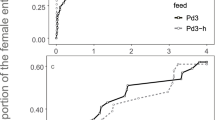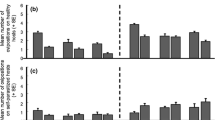Abstract
This study investigated the effects of host density and distribution on the patch-leaving behavior of Diadegma semiclausum (Hymenoptera: Ichneumonidae), a solitary endoparasitoid of larval Plutella xylostella (Lepidoptera: Plutellidae). Individual female wasps were released onto an experimental plant infested with host larvae at different densities and distributions, and were allowed to freely leave for an alternative host plant placed upwind of the experimental plant in a wind tunnel. The influence of host density and distribution, as well as within-patch foraging experience, on the parasitoid’s patch-leaving tendency was analyzed by means of the proportional hazards model. This study aimed to test the predictions of a number of patch-leaving models, including the Marginal Value Theorem, “rules of thumb”, and incremental or countdown mechanisms. The parasitoid’s patch-leaving tendency decreased with increased host density, more clustered host distribution, and unsuccessful host encounter as a result of host defense, but increased with successful oviposition. None of the simple rules of thumb such as fixed time, fixed number of hosts parasitized, or fixed giving-up time was employed by this parasitoid. The results agreed with the general predictions of the Marginal Value Theorem that patch residence time and numbers of ovipositions by the parasitoid increased with increasing host density. The decreasing influence of oviposition on the parasitoid’s patch-leaving tendency, regardless of host density or distribution, was consistent with the prediction of a countdown mechanism.
Similar content being viewed by others
References
Allison, P. D. (1997). Survival Analysis Using the SAS System, A Practical Guide, SAS Institute Inc., Cary, NC, USA.
Charnov, E. L. (1976). Optimal foraging, the Marginal Value Theorem. Theor. Popul. Biol. 9: 129–136.
Collett, D. (1994). Modeling Survival Data in Medical Research, Chapman and Hall, London.
Cox, D. R. (1972). Regression models and life tables. Biometrics 38: 67–77.
Driessen, G., and Bernstein, C. (1999). Patch departure mechanisms and optimal host exploitation in an insect parasitoid. J. Anim. Ecol. 68: 445–459.
Driessen, G., Bernstein, C., van Alphen, J. J. M., and Kacelnik, A. (1995). A countdown mechanism for host search in the parasitoid Venturia canescens. J. Anim. Ecol. 64: 117–125.
Godfray, H. C. J. (1994). Parasitoids: Behavioural and Evolutionary Ecology, Princeton University Press, Princeton, NJ.
Green, R. F. (1984). Stopping rules for optimal foragers. Am. Nat. 123: 30–43.
Haccou, P., and Meelis, E. (1994). Statistical Analysis of Behavioural Data, Oxford University Press, New York.
Haccou, P., De Vlas, S. J., van Alphen, J. J. M., and Visser, M. E. (1991). Information processing by foragers: Effects of intra-patch experience on the leaving tendency of Leptopilina heterotoma. J. Anim. Ecol. 60: 93–106.
Hemerik, L., Driessen, G., and Haccou, P. (1993). Effects of intra-patch experiences on patch time, search time and searching efficiency of the parasitoid Leptopilina clavipes. J. Anim. Ecol. 62: 33–44.
Iwasa, Y., Higashi, M., and Yamamura, N. (1981). Prey distribution as a factor determining the choice of optimal foraging strategy. Am. Nat. 117: 710–723.
Keller, M. A. (1990). Responses of the parasitoid Cotesia rubecula to it s host Pieris rapae in a flight tunnel. Entomol. Exp. Appl. 57: 243–249.
Keller, M. A., and Tenhumberg, B. (2000). New insight into the foraging behavior of parasitic wasps. In Austin, A. D., and Dowton, M. D. (eds.), Hymenoptera: Evolution, Biodiversity and Biological Control, CSIRO Publishing, Victoria, Australia, pp. 247-257.
McNair, J. N. (1982). Optimal giving-up time and the marginal value theorem. Am. Nat. 119: 511–529.
Nelson, J. M., and Roitberg, B. D. (1995). Flexible patch time allocation by the leafminer parasitoid, Opius dimidiatus. Ecol. Entomol. 20: 245–252.
Noldus, L. P. J. J. (1991). The observer: A software system for collection and analysis of observational data. Behav. Res. Meth. Instru. Comp. 23: 415–429.
Stephens, D. W., and Krebs, J. R. (1986). Foraging Theory, Princeton University Press, Princeton, New Jersey.
Tenhumberg, B., Keller, M. A., Possingham, H. P., and Tyre, A. J. (2001). Optimal patch leaving behaviour: A case study using the parasitoid Cotesia rubecula. J. Anim. Ecol. 70: 683–691.
van Alphen, J. J. M., and Vet, L. E. M. (1986). An evolutionary approach to host finding and selection. In Waage, J. K., and Greathead, D. (eds.), Insect Parasitoids, Academic Press, London, pp. 23–61.
van Alphen, J. J. M., and Jervis, M. A. (1996). Foraging behaviour. In Jervis, M., and Kidd, N. (eds.), Insect Natural Enemies, Practical Approaches to Their Research and Evaluation, Chapman and Hall, UK, pp. 1–62.
van Alphen, J. J. M., Bernstein, C., and Driessen G. (2003). Information acquisition and time allocation in insect parasitoids. Trend Ecol. Evol. 18: 81–87.
van Roermund, H. J. W., Hemerik, L., and van Lenteren, J. C. (1994). Influence of intrapatch experiences and temperature on the time allocation of the whitefly parasitoid Encarsia formosa (Hymenoptera: Aphelinidae). J. Insect Behav. 7: 483–501.
van Steenis, M. J., El-Khawass, K. A. M. H., Hemerik, L., and van Lenteren, J. C. (1996). Time allocation of the parasitoid Aphidius colemani (Hymenoptera: Aphidiidae) foraging for the Aphis gossypii (Homoptera: Aphididae) on cucumber leaves. J. Insect Behav. 9: 283–295.
Vos, M., Hemerik, L., and Vet, L. E. M. (1998). Patch exploitation by the parasitoids Cotesia rubecula and Cotesia glomerata in multi-patch environments with different host distributions. J. Anim. Ecol. 67: 774–783.
Waage, J. K. (1979). Foraging for patchily-distributed hosts by the parasitoid, Nemeritis canescens. J. Anim. Ecol. 48: 353–371.
Wajnberg, E., Rosi, M. C., and Colazza, S. (1999). Genetic variation in patch time allocation in a parasitic wasp. J. Anim. Ecol. 68: 121–133.
Wajnberg, E., Fauvergue, X., and Pons, O. (2000). Patch leaving decision rules and the Marginal Value Theorem: An experimental analysis and a simulation model. Behav. Ecol. 11: 577–586.
Wajnberg, E., Gonsard, P. A., Tabone, E., Curty, C., Lezcano, N., and Colazza, S. (2003). A comparative analysis of patch-leaving decision rules in a parasitoid family. J. Anim. Ecol. 72: 618–626.
Wang, X. G. (2001). Patch Exploitation by the Parasitoids of Plutella xylostella (L.): From Individual Behavior to Population Dynamics. Ph.D. Thesis, University of Adelaide, Australia.
Wang, X. G., and Keller, M. A. (2002). A comparison of the host-searching efficiency of two larval parasitoids of Plutella xylostella. Ecol. Entomol. 27: 105–114.
Wang, X. G., and Keller, M. A. (2003). Patch time allocation by the parasitoid Diadegma semiclausum (Hymenoptera: Ichneumonidae). I. Effect of inter-patch distance. J. Insect Behav. 16: 279–294.
Wang, X. G., and Keller, M. A. (2004). Patch time allocation by the parasitoid Diadegma semiclausum (Hymenoptera: Ichneumonidae). III. Effects of kairomone sources and previous parasitism. J. Insect Behav. 17: 761–776.
Wang, X. G., and Messing, R. H. (2003). Forging behavior and patch time allocation by Fopius arisanus, an egg-larval parasitoid of tephritid fruit flies. J. Insect Behav. 16: 593–612.
Author information
Authors and Affiliations
Corresponding author
Rights and permissions
About this article
Cite this article
Wang, X.G., Keller, M.A. Patch Time Allocation by the Parasitoid Diadegma semiclausum (Hymenoptera: Ichneumonidae). II. Effects of Host Density and Distribution. J Insect Behav 18, 171–186 (2005). https://doi.org/10.1007/s10905-005-0473-z
Received:
Revised:
Issue Date:
DOI: https://doi.org/10.1007/s10905-005-0473-z




